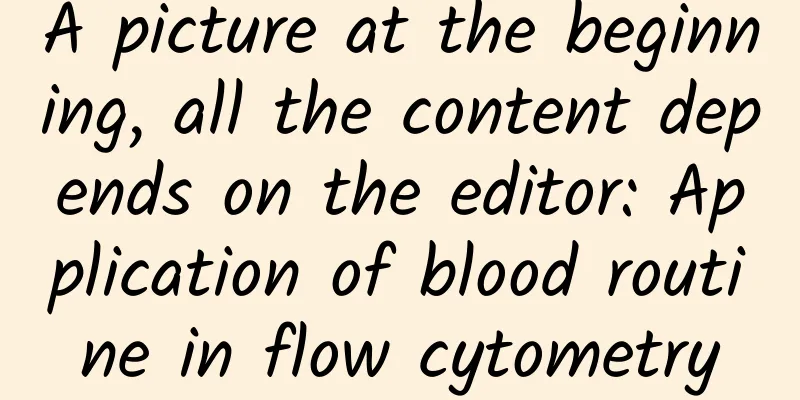A picture at the beginning, all the content depends on the editor: Application of blood routine in flow cytometry

|
Flow cytometry? Never heard of it! Have you heard of it, but don't know what it is exactly? Many people may not be familiar with it, but it’s okay, let’s take a look at a picture first. The two red areas in the picture above are obtained by this technology. Okay, let’s get to the point. Flow cytometry is a biological technique used to count and sort tiny particles suspended in a fluid . This technique can be used to continuously analyze multiple parameters of individual cells flowing through an optical or electronic detector. Flow cytometry is a technique that detects fluorescent signals of markers to achieve high-speed, one-by-one quantitative analysis and sorting of single cells or other biological particles in suspension. It has the characteristics of strong specificity, high sensitivity, fast speed, and can be analyzed and sorted. Flow cytometry detection signals are divided into two types: scattered light signals and fluorescent signals. 1. Scattered light signal Interlude: When a beam of parallel monochromatic light shines on a liquid sample, most of the light passes through the solution, and a small part of the light is scattered at different angles due to the collision between the photons and the molecules of the material, which changes the direction of the photons' movement. This light is called scattered light. Scattered light signals are divided into forward scattered light and side scattered light. The former is also called small-angle scattered light, and the latter is also called 90° angle scattered light. Forward scatter (FSC) is the scattered light signal collected in the forward direction. Generally speaking, FSC can reflect the size of cells. A strong FSC means a larger cell, and a low FSC means a smaller cell. However, when the detection target is a non-spherical cell (such as red blood cells, sperm, etc.), due to the inconsistent orientation of the cells in the fluid flow system, it is easy for the FSC of the same type of cells to differ greatly during laser detection, which requires special attention. Side scatter (SSC) is the scattered light signal collected from the side. SSC is more sensitive to the refractive index of the cell membrane, cytoplasm, and nuclear membrane, and its intensity is related to the fine structure and particle properties inside the cell. Generally, the more organelles and particles a cell has, the stronger its SSC is. Using the FSC/SSC dual parameter determination, several cell subpopulations can be identified from some samples without adding fluorescent dyes. The most classic is to use the FSC/SSC dual parameter to divide human peripheral blood leukocytes into three subpopulations: lymphocytes, monocytes, and granulocytes (as shown below). Lymphocytes have small FSC and SSC, monocytes have large FSC and medium SSC, and granulocytes have large FSC and SSC. (Is it unfamiliar? Three-category classification, isn’t it clear? In fact, many newcomers probably don’t understand it because many places have been eliminated) 2. Fluorescence signal There are two types of fluorescence signals. One is the fluorescence signal emitted by the cell's own fluorescence under laser irradiation, which is called cell autofluorescence; the other is the signal generated by artificially labeling cells with specific fluorescent dyes, such as monoclonal antibodies labeled with fluorescent dyes that specifically bind to the corresponding antigens of the cell membrane, cytoplasm, and nuclear membrane. These fluorescent dyes are excited by lasers. The strength of the fluorescent signal reflects the expression content of the cell antigen. Through the fluorescent signal, we can analyze the cell subpopulations and functions. 3. Scatter plot (a bit like the mosaic you have played) (1) Blood cell scatter plot: Using forward scattered light (FSC), side scattered light (SSC), side fluorescence (SFL), and forward scattered light signal width (FSCW), the blood cell analyzer displays the cell information through the position and density of scatter points on the quadrant plane. Based on the four signals, various scatter plots are generated to classify and count white blood cells, nucleated red blood cells, reticulocytes, and platelets, and detect abnormal cells and immature cells. (2) WDF detection channel Through this channel, we can distinguish four types of leukocyte subtypes in peripheral blood: lymphocytes, monocytes, neutrophils, and eosinophils. In addition, we can get some hints of abnormal cells, which is helpful for re-examination. (3) WNR detection channel The main function of this channel is to distinguish basophils. Finally, we got the results of the five-category white blood cell classification, but if you encounter any abnormal prompts, remember to order a re-examination! Okay, see you next time! |
>>: At what age is a boy considered to have delayed puberty? What can be done?
Recommend
Why did I have my period last month but not this month?
Many female patients have menstrual problems, so ...
Why do women have two urethral openings?
As we all know, whether men or women, there is on...
How to regulate the menstrual cycle?
Menstruation is very important for women. If mens...
Swelling of fingers during late pregnancy
It is normal to feel discomfort during pregnancy....
I took the medicine and it caused bleeding. What's going on?
In fact, many female friends nowadays do not know...
What should women do when they can't sleep at night?
Everyone knows that not being able to sleep at ni...
There is a smell after menstruation
Many women have a severe odor in their lower body...
How can women improve their immunity?
Women's physical fitness is generally not as ...
The main clinical manifestations of menopausal syndrome
Women will experience some symptoms after enterin...
Newly developed breasts
For most girls, secondary physical characteristic...
What causes itching in women
In real life, some women often experience vulvar ...
What are the symptoms of vulvar leukoplakia cancer?
The incidence of vulvar leukoplakia has been incr...
What kind of chicken is better for pig stomach wrapped chicken? Is it better to use old hens or tender chickens for pig stomach wrapped chicken?
We all know that chicken wrapped in pork belly is...
How to diagnose polycystic ovary syndrome
Polycystic ovary syndrome is a common disease amo...









